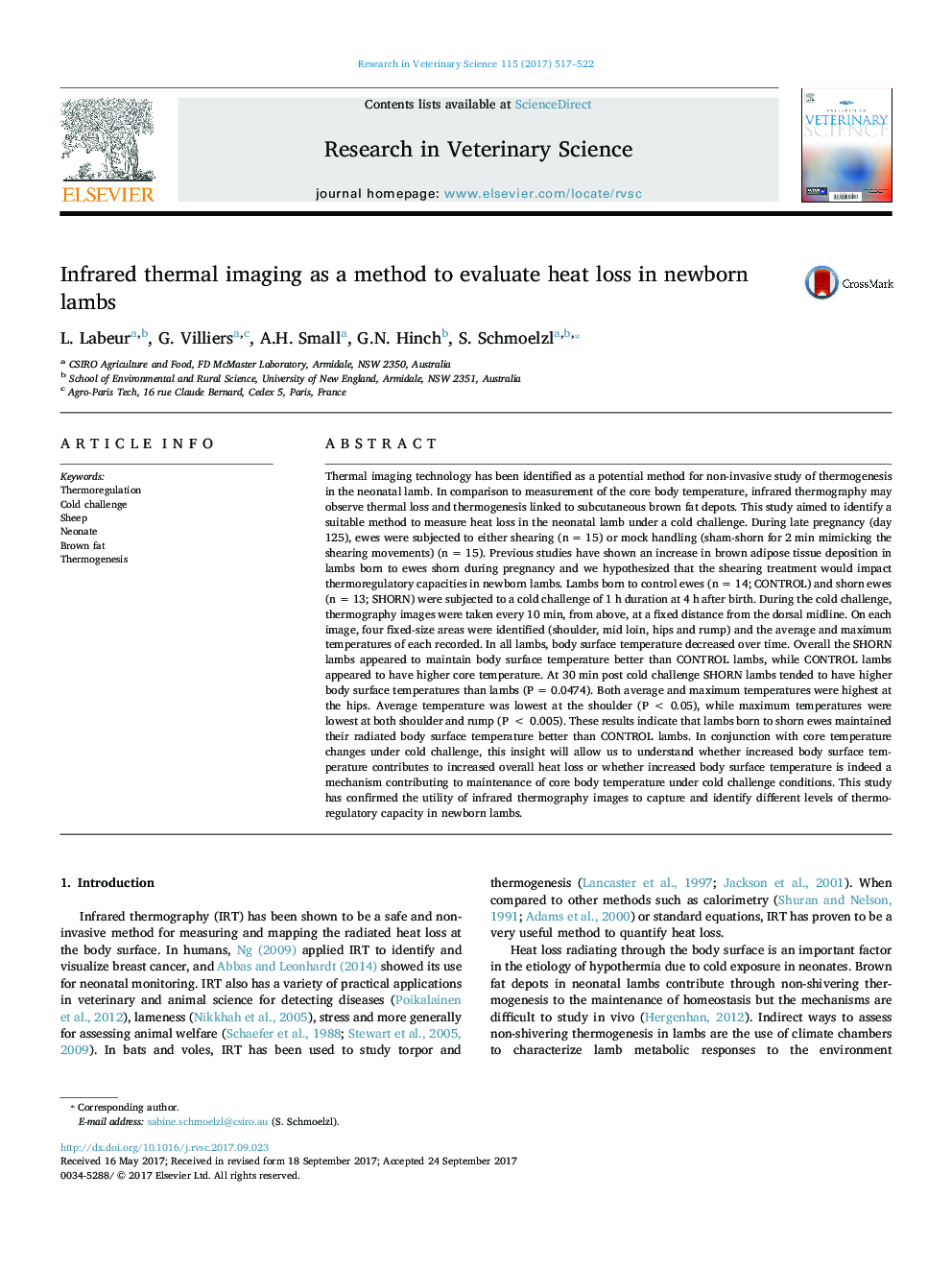| کد مقاله | کد نشریه | سال انتشار | مقاله انگلیسی | نسخه تمام متن |
|---|---|---|---|---|
| 5543866 | 1554296 | 2017 | 6 صفحه PDF | دانلود رایگان |
عنوان انگلیسی مقاله ISI
Infrared thermal imaging as a method to evaluate heat loss in newborn lambs
ترجمه فارسی عنوان
تصویربرداری حرارتی مادون قرمز به عنوان یک روش برای ارزیابی میزان تلفات گرما در بره های تازه متولد شده است
دانلود مقاله + سفارش ترجمه
دانلود مقاله ISI انگلیسی
رایگان برای ایرانیان
کلمات کلیدی
تنظیم حرارتی، چالش سرد، گوسفند، نوزاد چربی قهوه ای، ترموژنز،
موضوعات مرتبط
علوم زیستی و بیوفناوری
علوم کشاورزی و بیولوژیک
علوم دامی و جانورشناسی
چکیده انگلیسی
Thermal imaging technology has been identified as a potential method for non-invasive study of thermogenesis in the neonatal lamb. In comparison to measurement of the core body temperature, infrared thermography may observe thermal loss and thermogenesis linked to subcutaneous brown fat depots. This study aimed to identify a suitable method to measure heat loss in the neonatal lamb under a cold challenge. During late pregnancy (day 125), ewes were subjected to either shearing (n = 15) or mock handling (sham-shorn for 2 min mimicking the shearing movements) (n = 15). Previous studies have shown an increase in brown adipose tissue deposition in lambs born to ewes shorn during pregnancy and we hypothesized that the shearing treatment would impact thermoregulatory capacities in newborn lambs. Lambs born to control ewes (n = 14; CONTROL) and shorn ewes (n = 13; SHORN) were subjected to a cold challenge of 1 h duration at 4 h after birth. During the cold challenge, thermography images were taken every 10 min, from above, at a fixed distance from the dorsal midline. On each image, four fixed-size areas were identified (shoulder, mid loin, hips and rump) and the average and maximum temperatures of each recorded. In all lambs, body surface temperature decreased over time. Overall the SHORN lambs appeared to maintain body surface temperature better than CONTROL lambs, while CONTROL lambs appeared to have higher core temperature. At 30 min post cold challenge SHORN lambs tended to have higher body surface temperatures than lambs (P = 0.0474). Both average and maximum temperatures were highest at the hips. Average temperature was lowest at the shoulder (P < 0.05), while maximum temperatures were lowest at both shoulder and rump (P < 0.005). These results indicate that lambs born to shorn ewes maintained their radiated body surface temperature better than CONTROL lambs. In conjunction with core temperature changes under cold challenge, this insight will allow us to understand whether increased body surface temperature contributes to increased overall heat loss or whether increased body surface temperature is indeed a mechanism contributing to maintenance of core body temperature under cold challenge conditions. This study has confirmed the utility of infrared thermography images to capture and identify different levels of thermoregulatory capacity in newborn lambs.
ناشر
Database: Elsevier - ScienceDirect (ساینس دایرکت)
Journal: Research in Veterinary Science - Volume 115, December 2017, Pages 517-522
Journal: Research in Veterinary Science - Volume 115, December 2017, Pages 517-522
نویسندگان
L. Labeur, G. Villiers, A.H. Small, G.N. Hinch, S. Schmoelzl,
